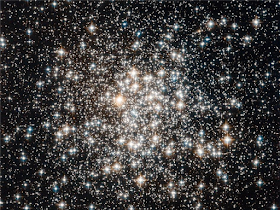No, these aren't cellphones at a darkened stadium concert.
A little larger than that. This is Messier 107. It's just one cluster of stars in our Milky Way.
The Milky Way has more than 150 of these immense star clusters.
And each one of these clusters contains hundreds of thousands of stars.
A little larger than that. This is Messier 107. It's just one cluster of stars in our Milky Way.
The Milky Way has more than 150 of these immense star clusters.
And each one of these clusters contains hundreds of thousands of stars.
The light from these hundreds of thousands of stars began its trip to the wide field camera lens of the Hubble Space Telescope 20,000 years ago, back around the peak or nadir -- depending on your seasonal preferences -- of Earth's last great glacial period when the Midwest was covered in ice and the Mississippi River had yet to form. That's before even Barbara Walters and Larry King were born, but George W. Bush was still to blame.
This star light has been traveling toward Earth ever since -- at the speed of 700 million miles an hour.
In related news closer to home, tonight after a nine-month journey in excess of 350 million miles the newest, largest planetary robot rover ever is scheduled to reach Mars and attempt an unprecedented complicated landing involving a parachute, cable crane and retro-rockets. Its goal is a two-year exploration of an immense eroded crater that should provide insights into Mars ancient geologic history.
Here's our original story on what the one-ton rover Curiosity looked like before it left JPL's lab in Pasadena, California last fall for its Thanksgiving launch from Cape Canaveral.
Take a look at this compelling JPL/NASA video below explaining what will be happening around 10:30 Pacific Time tonight 154 million miles from Pasadena.
It takes that long for radio signals from the craft to beamed up to a satellite orbiting Mars for relay back to Earth -- at just about the same speed as that starlight from Messier 107 has been traveling for the last 20,000 years.

No comments:
Post a Comment